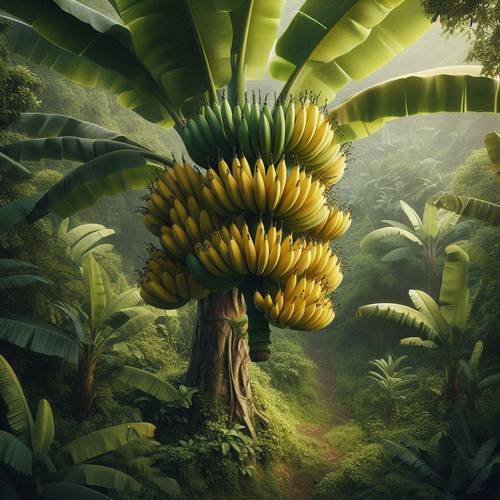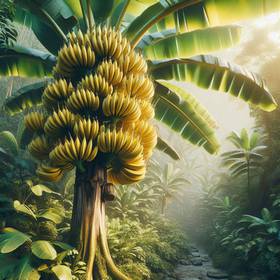Botanical Characteristics: The Science Behind the Fruit
The banana tree, scientifically known as Musa, showcases fascinating botanical characteristics. This herbaceous plant, reaching heights of 10-30 feet, is often mistaken for a tree due to its sturdy, tree-like "trunk" composed of tightly packed leaf bases. The broad leaves can grow up to 9 feet long and 2 feet wide.
Each plant produces a single flower cluster that develops into a bunch of bananas, typically consisting of 50-150 individual fruits. Bananas are technically berries, rich in vitamins and minerals, and propagate through underground rhizomes, ensuring the continuous growth of new shoots.
Each plant produces a single flower cluster that develops into a bunch of bananas, typically consisting of 50-150 individual fruits. Bananas are technically berries, rich in vitamins and minerals, and propagate through underground rhizomes, ensuring the continuous growth of new shoots.
Varieties of Banana Trees
• Cavendish Banana: The most widely grown and consumed variety worldwide, known for its sweet flavor and creamy texture.
• Gros Michel: Once the dominant commercial variety, it has a robust flavor and thicker skin but is now less common due to susceptibility to disease.
• Plantain: Starchier and less sweet than dessert bananas, often used for cooking and found in many tropical cuisines.
• Red Banana: Recognizable by its reddish-purple skin, it has a sweeter and slightly raspberry-like flavor compared to yellow bananas.
• Blue Java (Ice Cream Banana): Known for its bluish skin and vanilla ice cream-like flavor, this variety is popular in tropical regions.
• Lady Finger (Apple Banana): Smaller and sweeter than Cavendish bananas, they have a slightly tangy taste and are often used in desserts.
• Burro Banana: Squat and square in shape with a tangy, lemon-like flavor when ripe, this variety is versatile for both raw and cooked consumption.
• Manzano Banana: Also known as the apple banana, it has a firmer texture and a sweet, apple-like flavor.
• Pisang Raja: Popular in Southeast Asia, this variety has a rich flavor and is often used in making traditional desserts.
• Orinoco: Hardy and tall, these bananas are good for cooler climates and are often used for cooking due to their firm texture.
• Gros Michel: Once the dominant commercial variety, it has a robust flavor and thicker skin but is now less common due to susceptibility to disease.
• Plantain: Starchier and less sweet than dessert bananas, often used for cooking and found in many tropical cuisines.
• Red Banana: Recognizable by its reddish-purple skin, it has a sweeter and slightly raspberry-like flavor compared to yellow bananas.
• Blue Java (Ice Cream Banana): Known for its bluish skin and vanilla ice cream-like flavor, this variety is popular in tropical regions.
• Lady Finger (Apple Banana): Smaller and sweeter than Cavendish bananas, they have a slightly tangy taste and are often used in desserts.
• Burro Banana: Squat and square in shape with a tangy, lemon-like flavor when ripe, this variety is versatile for both raw and cooked consumption.
• Manzano Banana: Also known as the apple banana, it has a firmer texture and a sweet, apple-like flavor.
• Pisang Raja: Popular in Southeast Asia, this variety has a rich flavor and is often used in making traditional desserts.
• Orinoco: Hardy and tall, these bananas are good for cooler climates and are often used for cooking due to their firm texture.
Climate and Growing Conditions: The Banana's Ideal Environment
Bananas thrive in tropical and subtropical climates, ideally between 26°C to 30°C (78°F to 86°F). They require at least 12 hours of sunlight daily and prefer well-draining, loamy soil with a pH between 5.5 and 7.0.
Consistent moisture is crucial, so aim for 25-30 mm (1-1.2 inches) of water per week. High humidity levels of around 50-70% are ideal for optimal growth. Protect banana plants from strong winds, as they can damage the large leaves and hinder growth.
Consistent moisture is crucial, so aim for 25-30 mm (1-1.2 inches) of water per week. High humidity levels of around 50-70% are ideal for optimal growth. Protect banana plants from strong winds, as they can damage the large leaves and hinder growth.



